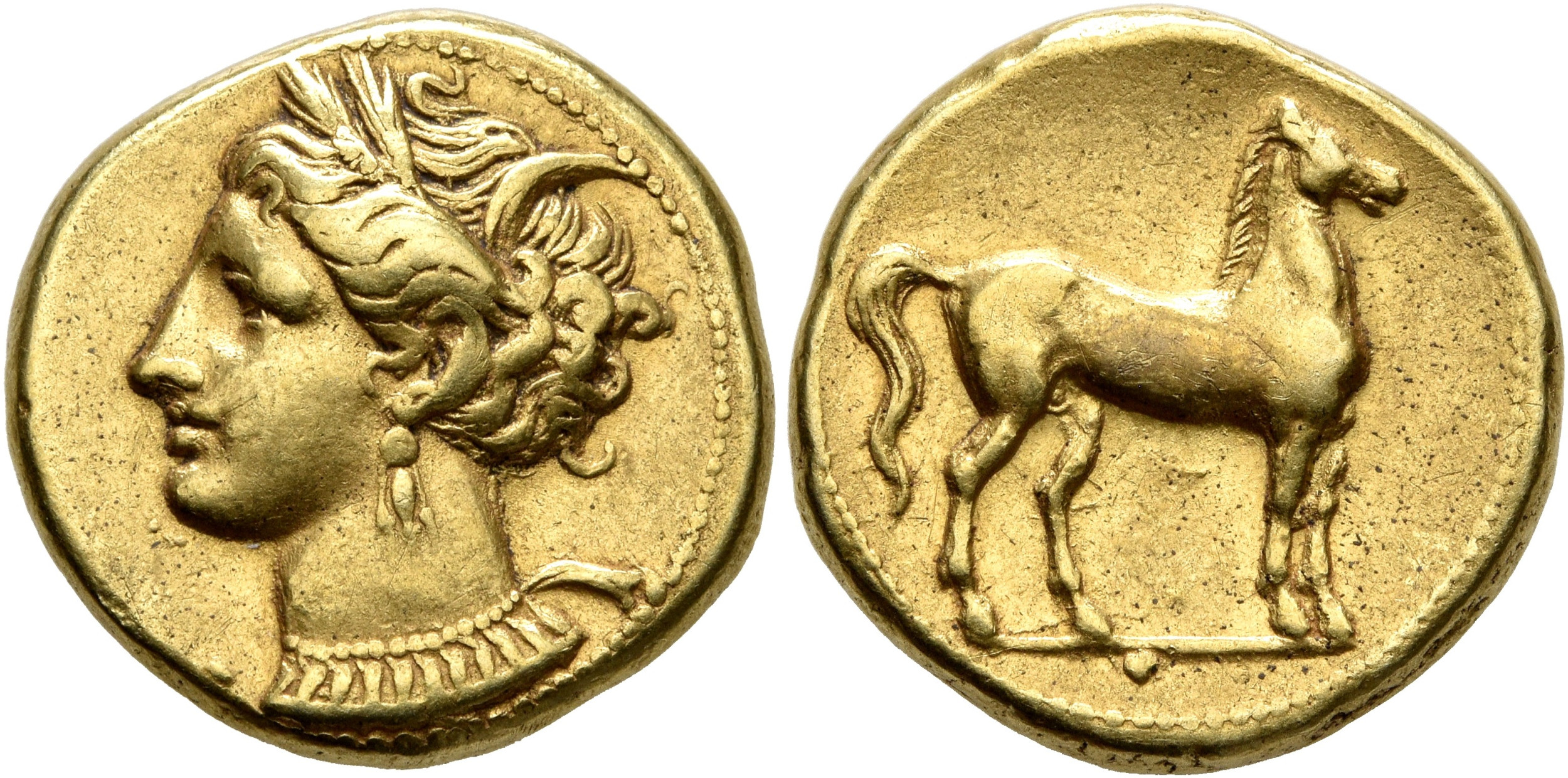Carthage, electrum, staters (310-290 BCE)
From SILVER
310 BCE - 290 BCE Electrum 100,170 kg
Description
| ObverseInscription or printing placed on the obverse.: | Head of Tanit to left, wearing wreath of grain ears, triple-pendant earring and elaborate necklace, to left, pellet |
| ReverseInscription or printing placed on the reverse.: | Horse standing right, below ground line, pellet |
Mint and issuing power
| MintIdentifies the place of manufacture or issue of a numismatic object.: | Carthage | Ancient regionAncient region.: | Zeugitana | Modern countryModern country: Tunisia | AuthorityIdentifies the issuing power. The authority can be "pretended" when the name or the portrait of X is on the coin but he/she was not the issuing power. It can also be "uncertain" when there is no mention of X on the coin but he/she was the issuing power according to the historical sources: | Carthaginian Empire |
Chronology
| FromIdentifies the initial date in a range assigned in a numismatic context. | 310 BCE | toIdentifies the final date in a range assigned in a numismatic context.. | 290 BCE | PeriodTime period of the numismatic object.: Hellenistic 323-30 BC |
Physical description
| MetalThe physical material (usually metal) from which an object is made.: | Electrum http://nomisma.org/id/el | Median weightMedian of the weights of numismatic objects (in grams). in grams | 7.50 | DenominationTerm indicating the value of a numismatic object. Examples: tetradrachm, chalkous, denarius.: | stater |
StandardStandard.: |
Image

H326 Cartage stater .jpeg [1]
References
| Die study referencePublication of the study: | Jenkins - Lewis 19631Jenkins - Lewis 1963, (série V) | ||
| Coin series referenceReference to coin series study: | Sear II2Sear II, n° 6462-6464, RQEMH3RQEMH, n° 326 | ||
Obverse dies distribution
| FrequencyFrequency of specimen in distribution. ᵖ | Number of obversesNumber of obverse dies. ᵖ (o) | % (o) | Number of coinsNumber of coins. (n) | % (n) | Die nameName(s) of the die(s). |
| 1 | 21 | 48.84 | 21 | 23.08 | 251, 252, 253, 254, 255, 256, 271, 272, 273, 275, 276, 277, 278, 283, 292, 293, 294, 295, 296, 297, 301 |
| 2 | 10 | 23.26 | 20 | 21.98 | 247, 248, 249, 250, 257, 265, 269, 302, 304, 306 |
| 3 | 6 | 13.95 | 18 | 19.78 | 258, 260, 262, 290, 298, 300 |
| 4 | 3 | 6.98 | 12 | 13.19 | 267, 274, 281 |
| 5 | 1 | 2.33 | 5 | 5.49 | 245 |
| 7 | 1 | 2.33 | 7 | 7.69 | 286 |
| 8 | 1 | 2.33 | 8 | 8.79 | 279 |
| Total | 43 of 43 | 100.02 | 91 of 91 | 100 |
Reverse dies distribution
no distribution is available
Quantification
| Number of obversesNumber of obverse dies. ᵖ (o) | 43 | Number of singletons (o1)The number of singleton coins. ᵖ | 21 |
| Number of reverse diesNumber of reverse dies. (r) | 57 | Number of coinsNumber of coins. (n) | 91 |
| Coins per obverse dieNumber of coins per obverse die. (n/o) | 2.12 | Coins per reverse dieNumber of coins per reverse die. (n/r) | 1.6 |
| Reverse per obverse ratioRatio of obverse dies divided by reverse dies. (r/o) | 1.33 | Percentage of singletons (o1)number of coins (n) divided by the number of singletons (o1) ᵖ | 48.84 % |
| Original number of dies (O) (Carter 1983 formula)The estimation of the number of coins according to Carter 1983 ᵖ | 66.78 | Coins struck if 20,000 as average productivity per dieCoins made if the average productivity for obverses (according to Carter) is 20,000. ᵖ | 1,335,600 |
| Original number of dies (O) (Esty 2011 formula)The estimation of the number of coins according to the singleton formula in Esty 2011 ᵖ (O) | 81.52 | Survival rate if 20,000 as average productivity per dieSurvival rate if average productivity is 20,000. ᵖ | 0.00007 |
| Coverage (o = % of O) (Esty 1984 formula)Esty 1984 - coverage (% of O) ᵖ (o = % of O) | 76.92% | Die productivity if survival rate 1/2,000Average productivity if survival rate is 1/2,000. ᵖ | 2,725.37 |
| Weight of silver (in kg) if 20,000 coins per die (O = Carter formula)Carter 1983 * Median weight * 20000 (*10 if gold or electrum) ᵖ | 100,170 kg <br /> 100,170 kg | Die productivity if survival rate 1/5,000Average productivity if survival rate is 1/5,000. ᵖ | 6,813.42 |
Remarks
Likely military
References
- ^ Jenkins, Gilbert Kenneth - Lewis, Richard Boyes (1963), Carthaginian Gold and Electrum Coins, RNS 2, London, 140 p., 38 pl.
- ^ Sear, David R. (1979), Greek coins and their values. Vol. II, Asia and North Africa, London, xlviii, p. 317-762
- ^ Callataÿ, François de (1997), Recueil quantitatif des émissions monétaires hellénistiques, Numismatique Romaine, Wetteren, X + 341 p.